Costumes & Characters
"Quidam is an exploration of the everyday. Robert Doisneau was a wonderful
source of inspiration for how the characters move and express their being.
The surrealists Magritte and Delvaux were a guide in choosing the color
scheme for the show, and also inspired how feeling and emotion are
represented in it. In Quidam, a young girl experiences loneliness,
anonymity, and alienation. She's dressed in orange, the color of action.
But she's surrounded by grey everywhere, and red, the color of love,
anger, and death." - Dominique Lemieux, Costume Designer
Artistic director Andrew Watson says creator Franco Dragone starts out
with a feeling, a phrase, a single word. With "Quidam," he began with the
idea of each person's individuality despite the appearance of anonymity in a
crowd. "When we sat down in the beginning," explains Mr. Watson, "we had
become aware of enormous numbers of displaced people - and these groups of
people have names to describe them: 'the homeless' or 'the refugees.' But
these groups are all made up of individual people who have their own histories,
who have their own lives - yet in our eyes they are all lumped together. So at
the top of the show, the family is dispersed, and everyone is in white. Bit by
bit we discover each other as individuals."
Other influences included the Belgian painter Rene Magritte (obvious in
the show's art work, depicting a headless man standing against a brick wall
and carrying an umbrella) and the work of French photographer Robert Doisneau.
In pictures such as "The Kiss (Hotel Du Ville)," Doisneau managed to take a
group photo, yet focus the viewer's attention on a single person. "You'd see
a whole group - he'd zoom in and suddenly, you'd see out of the group - that
everyone down there has their own story," he said. Such is the goal of Quidam.
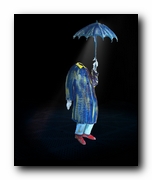 Inspired by surrealist art, the costumes of Quidam convey the alienation
of the characters inhabiting this dark-looking world. The costumes' patinated
textures and fabrics mimic the myriad colors of the urban landscape. The dominant
color - grey - is enhanced by deep, rich, warm colors embellished with flashes
of metal. At the start of the creative process, costume designer Dominique
Lemieux explored the many worlds of everyday life. The fabrics and
textures used in Quidam reflect the variegated hues of a megalopolis
inhabited by street people. Working in close cooperation, the costume
designer and the director have created characters and costumes that
reflect the performer personalities. Guided by the need to present each
performer as a unique individual, Dominique designed approximately 250
costumes (500 costume items, 30 hats, 20 real-hair wigs and 200-300
hand-painted shoes) that let the personality of each of the performers
come through.
Inspired by surrealist art, the costumes of Quidam convey the alienation
of the characters inhabiting this dark-looking world. The costumes' patinated
textures and fabrics mimic the myriad colors of the urban landscape. The dominant
color - grey - is enhanced by deep, rich, warm colors embellished with flashes
of metal. At the start of the creative process, costume designer Dominique
Lemieux explored the many worlds of everyday life. The fabrics and
textures used in Quidam reflect the variegated hues of a megalopolis
inhabited by street people. Working in close cooperation, the costume
designer and the director have created characters and costumes that
reflect the performer personalities. Guided by the need to present each
performer as a unique individual, Dominique designed approximately 250
costumes (500 costume items, 30 hats, 20 real-hair wigs and 200-300
hand-painted shoes) that let the personality of each of the performers
come through.
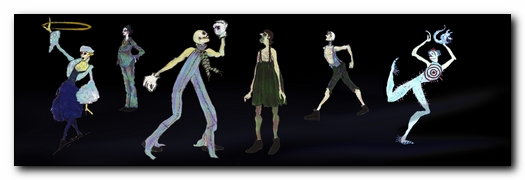
| |
Each artist has between two to seven costumes apiece and each costume is
specifically designed for that artist (with at least two spares of every
costume). For example, the costumes of the Banquine troupe are the same
design, but in different colors. At first, they are more colorful,
representing characters in real life, but later the colors become muted,
representing life after war or tragedy.
|
Quidam is the first show to use everyday clothing, though adapted, in its
acrobatic acts. The broken colors used for the costumes - from blue to pink
tones - create a dramatic effect and add to the show's gloomy overall
atmosphere. The basic material used for nearly all the costumes is
stretch linen - an innovation that gives them a worn look.
Eighty percent of the fabrics used in the show’s costumes are custom dyed.
These fabrics are usually white and are hand-dyed and printed in custom
colors shop. Basic costume and lining materials include leather, jute, linen,
crepe, wool, velvet, Lycra, and 42 varieties of silk and 30 varieties of
cotton from England, France, Italy and California. Around the world, fabrics
have been woven and knitted to the specifications of Cirque’s Costume Workshop.
They were then processed by dyers using a number of dyeing, printing,
airbrush, and tie-dyeing techniques.



The Family (Mom, Dad & Zoë)
Zoë is an average little girl. She is bored, yet curious, and she longs for the
fun and excitement she believes lies just beyond her reach. When her parents ignore her,
she suspends them “for a minute or two or three.” She is frustrated and disillusioned and
becomes swept up into the universe of Quidam. Lost admist a world where she finds no meaning,
she meets characters who encourae her to free her soul.
Zoë's Mother conveys an air of abscence and alientation. Inside her lie fear, frustration
and desire but she will soon rediscover the intense feeling of being alive through
pain and courage, play and love.
Lost behind his newspaper, ensconced in his den, Zoë's Father is completely, though
unqittingly, self-absorbed. His white shoes are the only indication of a hidden personality.
He will eventually open his eyes and realize what he's been missing around him, coming to
find himself among his family and loved ones once again.
John / Mark
With his tragically spare hairdo and comically svelte frame, John is a different kind of ringmaster.
Part game-show host and part substitute teacher with his own renegade lesson plan, he is our eerie yet
charming guide through the world of Quidam. A circumnavigator on a mysterious journey.
Karl/Fritz/Target (La Cible)
The Target is a living, human bulls-eye (possibly the personification of the carpet on
the family’s floor, which has the same design), fired at by everyone, left vulnerable perhaps
by a gentle nature and kindness, ironically remaining light-hearted and happy – answering to
everything with a smile. “A sweet, but frantic romantic” who can “fly with ease from the highest
trapeze.” With an infinite smile and moving with grace, he chooses to live in empty space,
present and absent at the same time, a companion to the lost girl for a little while.
Quidam
The Quidam may have stepped out of a surrealist painting or been conjured up out of Zoë's
imagination. He is anonymous-he is everyone, and, at the same time, he is no one. The hat of
the "quidam" has become an emblem of the show: to wear someone else's hat is to open one's
eyes to another person's reality; to accept and understand that person - to give that person
a voice.
Boum Boum
Boom-Boom, a bald guy with gloves for hands, is aggressive and physically fit.
He brings forth the rumble of thunder and the flash of lightening with just the
clash of his hands, showing us some of the more unpleasant sides of Quidam though
protecting us at the same time. His ear piercing roars of disgust will grab your
attention. And yet, he is lifeless, as though his body lives on only because his
soul refuses to leave it.
Les Égarés
Les Égarés are lost individuals who gather together in the streets and abandoned buildings of Quidam.
They sublimate their suffering, transforming it into something magical and inspiring.
Les Chiennes Blanches
The silent chorus, the nameless and the faceless; the dehumanized, mechanical
crowd, simultaneously leading and following.
The Aviator
The Aviator has skeletal wings, but doesn't look quite ready to take off.
Perhaps he doesn't know he has wings. Perhaps he knows, but can't fly. Perhaps,
like Icarus, he has tried and failed. Or perhaps he simply wants to escape this
world and its problems.
Funny Bunny
A female looking for love all the time! Plays, and likes to tease. Never
knows if the one she has is the good one, so she goes to someone else. Chases
and gets chased by other characters. “A genius in ecology, lovey-dovey, and
astrology.” Has no tail, and each ear is twice the length of her head! Her
costume is essentially made of wool, while its ears are made from newsprint.
Les Femmes Voilées (Veiled Women)
A small number of veiled women take the stage during the Cloud Swing performance.
While the artist is above them swinging precariously by her rope, these women are
also... twisting and tying ropes around their necks.
Clowns
Clown Set #1: Les Macloma
Guy Pannequin, Alain Cantonne, and Philippe Azoulay of France - are most
remembered for being the comedic trio featured on Quidam's DVD, filmed live
in Amsterdam in 1999. The clowns Red, Yellow, and White, were a wondrous sight
to behold and their antics - from a moderately entertaining routine about the
jealousy of a clown who can't blow up balloons for a colleague whose body is
literally covered with them, to floating around the stage in hot-air balloons
made from cardboard boxes, and playing musical notes on inflated balloons and
a one-string violin - were no less... antic! ("Ragazza!").
The trio began their journey with Quidam in Montreal and continued with the
show through its initial steps in the United States, up through San Jose,
California (September 1997), before turning over the clowing to Kotini Jr and
Alosha. However, once the show hopped shores and began touring Europe,
Les Macloma's brand of clowning returned to Quidam and remained for
another four years. In 2002, Les Macloma semi-retired from Quidam but their
antics lived on through Les Frères Velasquez (Marie-Élizabeth Cornet,
Gabriel Chamé Buendia, and Begoña Gomez; North America II, 2002-2003)
and Les Don Quijoles (Gabriel Chame Buendia, Joshean Maulvon, and Royo;
Japan, 2003-2004), trios who built upon the Les Macloma legacy by
performing their comedic skits.
Clown Set #2: Kotini and Alosha
Once Quidam was ready to leave sunny California and continue throughout
the United States, the surreal world of Quidam became populated by Alosha
(Alexey Mironov) and Kotini. Kotini, the Red Clown, was a crotchety, mean old
soul who didn't seem to care whose feelings got hurt by his antics. He tormented
Zoë throughout most of her journey, but saw the error of his ways in the end
(becoming her friend.) He was easily recognizable; he walked with a limp and was
downright gloomy. Alosha, the Yellow Clown, in contrast was likeable enough, but
not too bright. Together the two were crude and sometimes unwanted, but found a
way into the narrative of Quidam never-the-less. [The pair joined in Denver and
continued throughout the rest of the North American run.]
Clown Set #3: Toto and Voki
In 2004, with subversive, crazy audience participation numbers, Toto (Guillermo
Castineiras) and Voki (Voki Kalfayan) brought a contemporary North American
vision of clowning to the show by bringing some of David Shiner's best acts. In the
"Film Scene" (as seen in Nouvelle Experience) Voki plays an embittered film
director who tries to guide four audience members through a few routines for a
shocking scene in his film. The dictatorial director grows increasingly frustrated
with his actors’ abilities (or inabilities), and hence the comedy. Another is the
re-introduction into what has become a crowd-favorite in "The Car", in which Toto
selects a female audience member to go on a drive-date with. {NOTE: Sometimes
it's just Voki, sometimes it's just Toto; In 2006, Voki left and and others have
played opposite Toto, such as: Ambrose Martos (2006), Eric Davis (2007-2008),
and Fabio Esposito (2010) amongst others.}
|
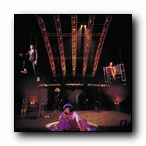
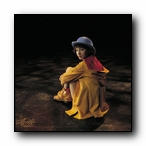
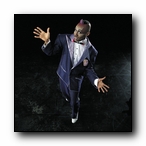
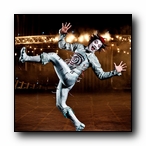
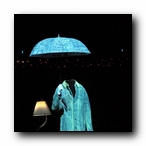
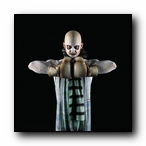
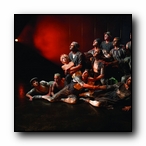
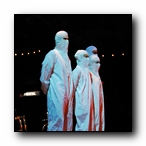
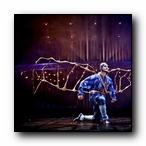
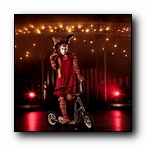
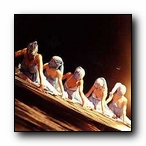

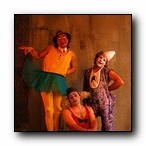

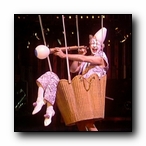
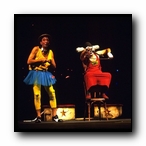
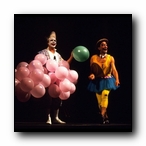
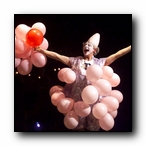
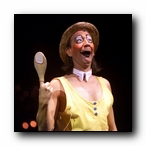
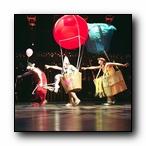
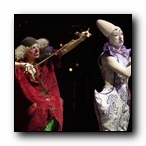
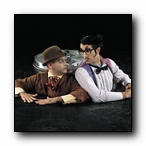
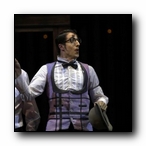
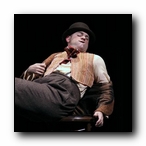
|
|

![]()




